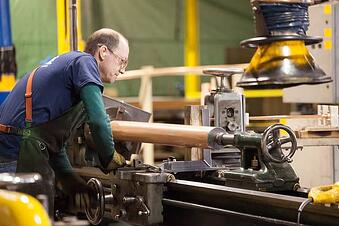Increase Efficiency & Profitability With the 5S Methodology

We organize and clean at home. Doing the same at our manufacturing facilities and offices will increase both efficiency and our bottom line. This is Part 1 of a two-part series that discusses how manufacturing organizations can utilize the 5S methodology to establish a strong foundation of discipline needed to increase efficiency and profitability.
The 5S’s of the 5S Methodology
-
Sort: (Organization) Classifying and organizing all items in each work area into two categories – needed and not needed.
-
Set in Order: (Orderliness) Minimizing the searching for and retrieving of items necessary at each workplace.
-
Shine: (Cleanliness) Cleaning the entire workplace, including walls, windows, floors, desks, and equipment.
-
Standardize: (Standardized cleanup) Preventing dirt in the first place, establishing and maintaining expected standards.
-
Sustain: (Discipline) Adhering to the rules and agreed-upon standards in the workplace.
Although we refer to all five of the 5S methodology, sort (organization), set in order (orderliness), and shine (cleanliness) form the key elements of the 5S organization system. Note, these stages are activities meant to be continual, not things that someone does once and stops.
The 5S’s offer the discipline required to apply stringent standards, enabling 5S organizations to remain flexible enough to adapt their standards as conditions warrant. Safety is sometimes included as a sixth S. However, safety considerations must be intertwined within all of the steps in the 5S methodology.
How can we expect our machine operators or people in clerical offices to maintain their focus on achieving customer expectations when surrounded by dirt and clutter? The answer is we cannot. However, dirt and clutter describe the condition of many manufacturing shop floors and office environments. Change this paradigm. People feel better about themselves and their employers if their surroundings are clean and more organized.
Using the 5S Methodology to Combat Waste
Variation is everywhere. Variation manifests itself in our daily lives – getting a flat tire on our way to work or losing our electricity due to a power outage. And where we find variation, we find waste. Manufacturers encounter variation constantly. Customers’ needs constantly change as their markets change.
Customers want new products made from new materials, or they improve existing products. Simultaneously, new specifications and tighter tolerances are being demanded. Schedules change due to revised delivery needs. Consequently, manufacturers must remain flexible, adapt to their changing marketplaces, and continue to combat variation and waste to survive.
As we attempt to uncover and remove the sources of variation, we soon discover our physical workplace itself can be one of the largest contributors to variation and waste. Unmarked storage locations, missing tools, leftover tools from previous jobs, disorganized desk drawers, broken machines taking up room, and general dirt are a few examples of things that get in our way and cause wasted time.
To combat these conditions in any manufacturing or office environment, use the 5S methodology. Manufacturing organizations can use this 5S improvement process to eliminate sources of variation to establish the strong foundation of discipline needed to increase efficiency and profitability.
The 5S methodology terms are of Japanese origin (seiri, seiton, seisō, seiketsu, and shitsuke), but the concept of 5S efficiency came from methods that originated in the United States (more on this in Part 2 of this series). Mr. Hiroyuki Hirano offers a simple, yet accurate analogy about the 5S process. Mr. Hirano, a Japanese consultant, compares 5S with giving our workplaces a shower – “We personally want to be clean, so wouldn’t our workplaces?” If our workplaces could answer, no doubt they would agree!
Starting your 5S improvement plan? Make sure you have a solid enterprise resource planning (ERP) solution to support and record your process. Contact us to learn more about how we can help you with your ERP software.
Image credit: "Premier Kathleen Wynne tours the manufacturing facility of RenewABILITY Energy Inc. in Kitchener, Ontario" by Premier of Ontario Photography via Creative Commons License Attribution-NonCommercial-NoDerivs 2.0
Scott Holter is the Director of Meaden & Moore’s Business Solutions Group. He has spent 20 plus years in manufacturing and technology consulting.








